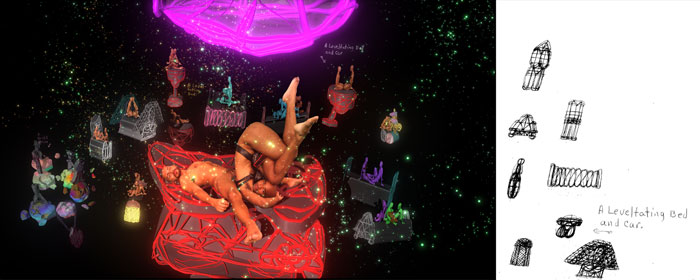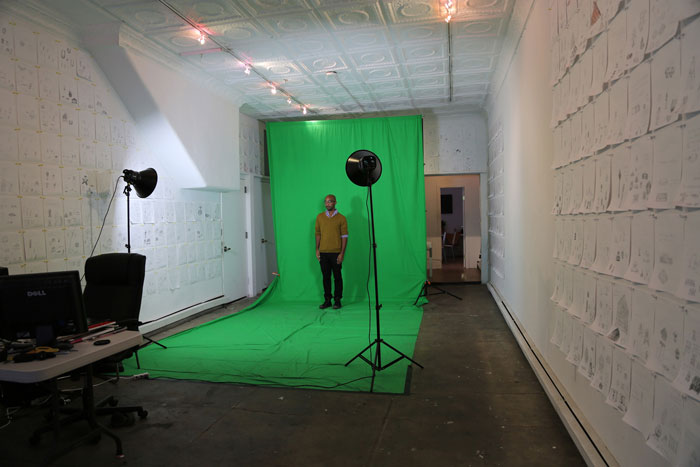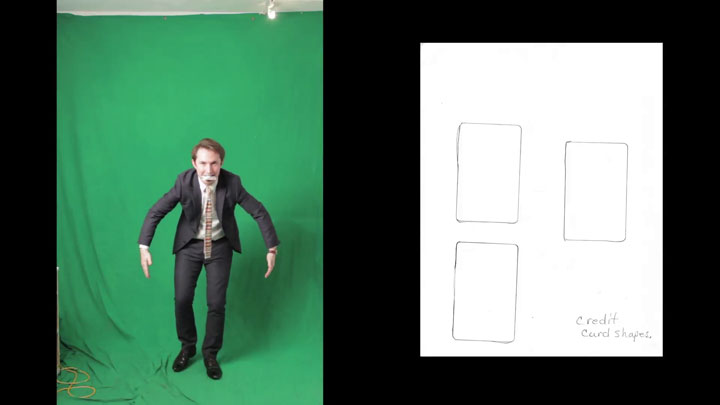Registration and Development Intern Martina Caruso interviews New York-based artist Jacolby Satterwhite on his project repurposing schematic drawings made by his mother into animations and performances. Grey Lines, the newest chapter of this ongoing work, was part of Recess’s recent signature program, Session from August 17 – October 12, 2013.

Jacolby Satterwhite, Island of Treasure and Leveltating Bed Drawing, 2013. C-Print and video still from Reifying Desire, 55 x 30 inches. Image courtesy of the artist.
Martina Caruso: Jacolby, your Grey Lines is a new chapter of The Matriarch’s Rhapsody, a body of work primarily based on drawings by your mother, as both inspiration and source material. You worked on this series for almost three years now. How did you begin the project and what were the ideas you thought you were originally going to explore?
Jacolby Satterwhite: I originally thought I was going to create a video game, and I decided to focus on composition, choreography, narrative, etcetera. Then I realized I was actually playing a video game through the process of synthesizing incongruous ideas, mediums, and archives.
MC: In Grey Lines you decided to elaborate on the meaning of your mother’s drawings in a performative project that involves live dance performance and interaction with the public. Can you tell us more about this new experimentation?
JS: After a few years of exploring my own subjective interpretations of my mother’s drawings through performance and 3-D animations, I decided it was time to introduce another databank of inspiration. Outsourcing performance to the public was a way for me to archive unfamiliar languages from others’ movements and speech and find ways to bridge them with my archive of 3D translated drawings, movements, and narrative tropes. That space between mediums is the “grey” area. I am always looking for ways to expand that “grey” area, where my content lives.
MC: Looking into your works, it really seems that you try to create different connections between past, present and future. How do you juxtapose and relate your family memories and personal connections with today’s world?
JS: The artist’s subjective synthesis of private, public, and liminal spaces often reveals the politics, biases, and gender issues that lie within and between them. My family photographs are a document of how the outside world influenced my relatives’ performance, fashion, style, composure, etcetera.
MC: Jacolby, your mother’s works are actual drawings of hybrid objects that she intended to sell on home shopping networks. What do you think about how ideas of consumerism emerge in your work?
JS: I don’t think about consumerism, I think about the potential of art.
MC: Your practice reminds me of Dada and Surrealist attitudes, with their accumulation of multiple drawings to create a new media work with a nonsense narrative. Did you look into those early 20th century cross-media productions?
JS: Artists like Man Ray and Marcel Duchamp were early influences and helped validate my meta-narrative process, where not only the physical medium but the metaphors and visual narrative of a work constitute a message about the process.
MC: I read in an interview that you used to carry your mother’s drawings around when you were a sophomore in college, and I see a sort of mysticism pervading your work. How do you feel about animism?
JS: I feel as if animism is the best way to describe my practice. Every time I solicit a performance from a pedestrian on the street, I hand them a drawing and request that they respond to the drawing as if they are the object, or as if they are using the object. I am interested in the nuances that are generated from an individual’s life experiences building up to that moment that he performs for me.
MC: What do you think will be your next step?
JS: I’m interested in how sculpture can be viewed as a time-based medium without being 4D. I am going to pursue this through very detailed, cylindrical 3D printed dioramas of the crystalline models I’ve built for my work. I have found a joy in still images, too, and I have been creating large scale C-Prints. They allow me to explore concerns I have with painting.
MC: Just one last question: do you normally draw during your daily studio and residential life?
JS: Not anymore, since most of the day I am tracing, constructing, and re-drawing my mother’s drawings, dancing in a lyrical, line based choreography for the camera, and compositing all of the information together in 3D animations. By the time I can get to my own original drawing, it’s bed time. Maybe I’ll take a break and do my own body of drawings in the near future.
MC: Well, in terms of translating an idea into a new medium or communicating through line, I think your current practice is already a challenging interpretation of what drawing can be!


